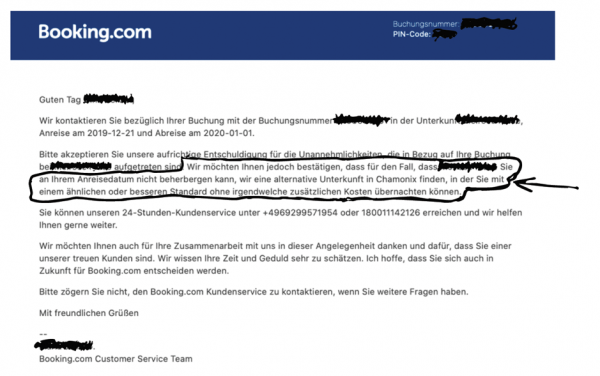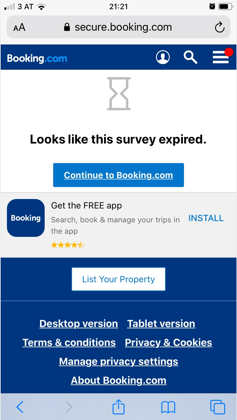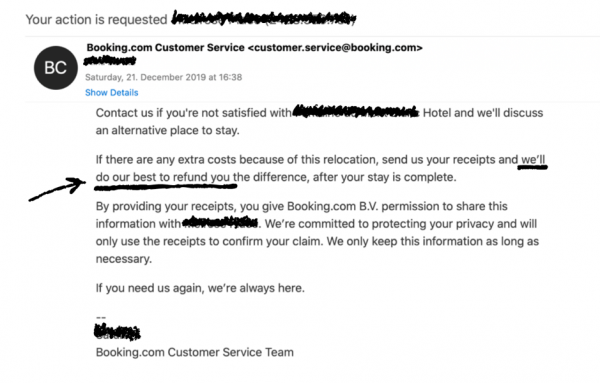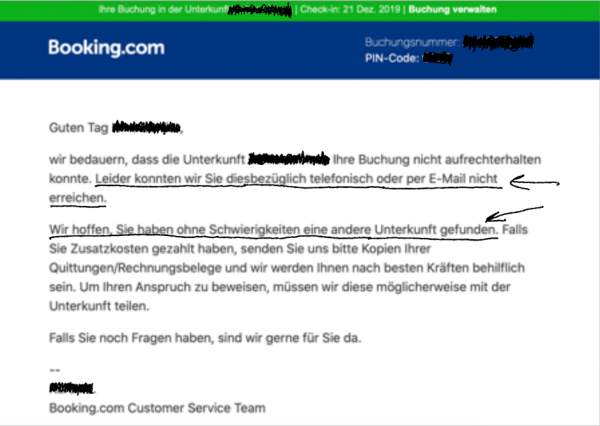Booking.com: When Things Go Wrong (and Why User Testing Should Include Worst-Case Scenarios)

February 8, 2020
Sometimes, things will go wrong in life.
It sucks, especially when you end up in a highway hotel for your Christmas family vacation instead of the lovely apartment you had booked months in advance.
“C’est la vie”
So, here we are in Chamonix, and the host of the apartment we had reserved on booking.com hasn’t shown up.
We call booking.com and they initiate the process they have in place to take care of such situations. In the course of the following few hours, we will experience firsthand what, I suppose, you could call booking.com’s worst-case use scenario.
The situation is already bad, but how is the process that deals with it?
Things can go wrong – that is a part of life. It’s not fun if it happens to you, but you deal with it. The least you’d expect is for the unpleasant situation to be handled as smoothly as possible.
Even though I was on vacation and this was my private experience, I could not help but see the situation from 2 angles:
The first was the private angle, the “I am a worried mum, freaking out that our holiday plans are crushed” side of things, which I intend not to dwell on in this post. The second is the less emotional observation of the overall user experience through my professional lens as a user researcher and Web business optimizer.
To me, this whole experience was a great reminder of how important it is to conduct user tests, not just on main business flows – the ideal beautiful happy customer journey – but also on worst-case scenarios.
Findings from my unintentional user test of booking.com’s worst-case scenario
Before I get to the usability aspects, I need to give you some background on the whole experience.
In a rather unusual move, we booked our Christmas holiday well in advance. We had our apartment reserved all the way back in August. As we had not heard back from the renter after asking a question through the booking messaging system and a few phone call attempts, I contacted booking.com to make sure everything was all right.
The agent on the phone reassured me that I need not worry: Even in the worst case, the host of the accommodation not showing up when we arrived, booking.com would find us an alternative accommodation. I reminded him that we booked our apartment during the highest peak season of the year (over Christmas and New Year) in a very popular place. He reassured me that this posed no problem, that they are used to such situations and that they always find alternative accommodations from among their vast offerings.
Over dinner, my husband and I discussed our astonishment at this reassurance. But then again, who should know better than a platform like booking.com?
To be on the safe side, we decided to get this guarantee in written form. I e-mailed customer support and they confirmed via e-mail what the agent had told us on the phone:

E-mail from October 23rd, 2019, guaranteeing that if the host of our accommodation did not show up, booking.com would find as an alternative accommodation of similar or better standards in Chamonix at no extra cost.
Fast forward to a few days before Christmas: We park our car in front of the apartment we had booked (and paid for already).
Nobody shows up.
Okay, now what…?!
We call booking.com’s customer support. They tell us they will contact the host and that he has 30 minutes to come and meet us, or else our stay will be cancelled.
Thirty minutes later, nobody has shown up.
We call the hotline again. The phone agent now tells us that they will start the process of relocating us. We should check our e-mail regularly within the next 20 minutes, as they will send over recommendations for alternative accommodations.
About an hour later, our inbox is still empty. We have received no alternative suggestions.
We call the hotline again. This time we speak to another lady. She apologizes and says she will send suggestions shortly. She mentions that it will be very difficult at this time of the year to find something. I tell her that customer support had guaranteed in writing that they would find us an adequate alternative in Chamonix at no extra cost and that I am counting on that promise.
A little while later, we finally get an e-mail suggesting a hotel.
Our excitement quickly turns into major disappointment:
The hotel is not in the destination we had chosen but in another, much smaller ski town next to Chamonix. In fact, it is not even in this other smaller ski town; it is a “highway hotel” 2 exits away, right next to a highway rest area.
There is no room available that could accommodate all 4 of us, so we will be split in 2 different rooms.
We tell the call center agent that this is not an option and remind her of their promise to find an alternative in Chamonix. She states that she tried to find an apartment or hotel for the 4 of us, not just on booking.com, but also on Airbnb, Expedia and other platforms, and that there was nothing available. She promises us that she will research more and send another alternative.
A little while later, another e-mail arrives with a second suggestion, this time in a hotel a 1-hour car ride away from our original destination.
At this point, we start to get nervous. The bold reassurance of the phone agent many weeks ago, as well as the confirmation e-mail, seemed to be worth nothing…
Frantically we start checking for alternatives ourselves, and I wish I would have captured a screenshot of my phone: The only available apartment on booking.com for 4 in Chamonix during our travel time was offered for – brace yourself – 55,000 euro.
Hours have gone by and there is no solution in sight.
While I am yet again in the hotline’s waiting queue, my husband continues searching for alternatives on his phone.
He notices that the first week over Christmas is less of a problem than the second part of the vacation, the one over New Year. Browsing on booking.com, he finds a family hotel room in a hotel in Chamonix for the first week.
Lacking any better alternatives, we decide to offer to split our stay between 2 hotels: 1 week in the hotel we found in Chamonix and the remaining time in the “highway hotel” they had recommended as an alternative.
So here I am again, back in the hotline queue, waiting to speak to an agent to suggest our idea. It was not a satisfying solution, but because they were not able or willing to offer us anything remotely corresponding to our original booking during the course of the last 3 hours, it seemed like our only option. It was now clear to us that booking.com would not stick to their promise of finding an alternative in Chamonix.
Every time I called, I was connected to a different agent. Every time, I had to re-explain my situation. I started wondering if they were using any customer service software, as agents never seemed to be up to date on the latest status of the relocation process or what other agents had previously communicated.
I propose our solution. The new agent refuses it on the grounds that it is too expensive.
For the first time that day, I start to get impatient with the customer service agent. How can this be too expensive? A previous agent had told me the price range she had gotten approval for from her supervisor. Our suggested plan was within that budget!
Shouldn’t a customer service software track such approvals?
After another long hold, while she was talking to her supervisor, she finally tells me that we can go ahead with this plan.
She explains that once I book the new hotels, they will cancel the original booking and process the refund in the next couple of days. The new hotels have to be paid for by me, and I can send in the receipts after the stay to get the difference refunded.
The e-mails we get, however, send a totally different message:
The e-mails from booking.com suggesting alternative hotels do not say that they “will refund you the price difference.” They say, “We’ll do our best to refund you the difference.”
That felt like a slap in the face.
“Do your best” to me sounds like “maybe, or maybe not.”
Not only do I have to wait for the refund for the cancelled apartment (that takes 7-12 days), on top of it, I now have to pay for new hotel bookings, which, due to the last-minute situation, come with a high price premium.
And then they may or may not reimburse the difference?!
Frustrated, I ask the agent to send me an e-mail that clearly confirms that the price difference will indeed be refunded.
A little while later, I receive such an e-mail, but… it is not mobile optimized.
I can barely read it on my small phone screen; zooming in does not work properly, and the links I need to book the new hotels are almost impossible to click on.
By now 6 hours have gone by, and all I want is to have this finally sorted.
It takes me several attempts to manage to open both links in the e-mail.
Next problem: My mobile Internet connection is not strong enough to load the pages. I move around to find a better signal and finally find a bar with Wi-Fi, which allows me to load the pages and finalize the bookings on the booking.com site. Or so I thought…
By now it is pitch dark outside. We finally get to our new hotel. I check my phone and see that the second hotel, the one I lovingly labelled the “highway hotel,” is threatening to cancel my booking because they are having problems charging my credit card.
I guess my credit card was maxed out. After paying for the original apartment booked on booking.com, some Christmas shopping and a new computer, I now had the unexpected additional payment for the 2 new hotels. The hefty last-minute price premium seemed to be over my limit.
I am guessing this is a common problem others in similar situations might run into: The first payment is not yet refunded and new premium-priced last-minute hotel bills stretch your card’s limit.
The hotel did not accept any payment method other than credit card but was kind enough to agree to keep the reservation, taking a small down payment, and I would settle the rest when we checked in.
The long day came to an end, but I wondered once again if booking.com agents work with any kind of meaningful customer service software or CRM system. During the rest of the evening, I received 3 more phone calls from different call agents confirming 3 different topics, as well as conflicting e-mail messages, such as the one below.
How could they send me an e-mail apologizing that they were not able to reach me via phone or e-mail when we had been in constant contact via phone and e-mail?
Why do they say that they hope I found another accommodation?
I booked the alternative accommodation via the links they had sent me and via their own platform. So how could they not know that I booked? They even sent me confirmation e-mails for these new bookings.
Summing up the key pain points of my user experience
1. An unkept promise
When the call agent promised me that booking.com would find an alternative accommodation for us in Chamonix over Christmas in the case that our host did not show up, I did not believe my ears. How on earth would they find a last-minute alternative during this peak vacation time? But then again, who should know better than a platform like booking.com? They have firsthand experience and all the data points to tell them about availabilities at any point in time.
On top of the promise made over the phone, they also confirmed via e-mail.
Keep it or leave it:
To date, I still cannot understand how booking.com could make such a promise. Either they need to stick to it no matter what (even if the alternative means paying 55,000 euros for a last-minute apartment) or not make this promise in the first place.
2. On hold or kicked out
I had to wait several minutes to get through to an agent each time I called the hotline. On various occasions I was kicked out of the phone line due to technical problems on booking.com’s side. In some instances the agents called back, but in others they didn’t. This meant at least another couple of minutes to get back on the phone with another agent. All in all, I spent 45 minutes on the phone, of which I estimate 80-90% was pure waiting time (either in the queue to get to an agent or on hold while agents were talking to their supervisors) during the relocation process.
Once you are in the relocation process, it would be great to get some type of preferred access or priority service so waiting times are reduced. Also, a dedicated team with the decision power to handle relocations would be practical so that long on-hold periods (e.g., to get supervisor approval) can be avoided. I assume that in most last-minute relocation cases, a higher budget is necessary to pay for the associated price premiums, so agents should be able to deal with those cases directly and efficiently.
3. Explaining the situation over and over again
A big pain point in this half-day process was the fact that there was no seamless customer journey experience across all interactions and touch points. Each time I got on the phone, I spoke to a different person who was not up to date on what other agents had already initiated, handled or promised. It seemed the agents were lacking a tool that stored all our communication exchanges (e-mails from agents, automatic system notifications and oral agreements via phone). Either that, or they were not making use of it.
4. Conflicting, unclear messages
Another major frustration point was conflicting or unclear messages. Automated e-mails (at least I assume they were automatically triggered by the system) did not fit our situation.
–> They cause confusion.
The phone agent tells you one thing (“You will get the additional cost refunded”), and the e-mail that follows tells you something else (“They might refund it”).
–> You feel fooled and cheated.
Instead of making users feel good, understood and supported in a situation that is already quite negative and stressful, conflicting messages stir up additional fear and mistrust.
5. Bad mobile usability
I assume most travellers in such situations use their phone to handle the relocation process communications. You can probably imagine how frustrating it is to receive a non-mobile-optimized e-mail…
6. Payment problems
Because booking.com asks you to pay for the alternative accommodation yourself (they only refund you after your stay) and at the same time does not immediately refund the payment made for your original accommodation, you quickly wind up with huge sums being charged to your credit card.You are basically paying for 2 vacations (1 at the price you had planned and 1 at a hefty price premium due to last-minute booking).
I would not be surprised if others have experienced similar credit card limit situations.
User testing worst-case scenarios can help you shine when things go wrong
UX is such an important part of brand loyalty. Ideally, it creates a positive and memorable experience for your customers, so that they want to come back to you again and not go to your competition.
In the best case, they fall in love with your products, they get excited at the service you provide and they move on to happily spread the word about your company.
But not all customer journeys are magical ones.
I know that it is very complex to conduct user tests and user research on worst-case scenarios, but it is worth it. If you manage to shine when things go wrong, you can really turn a negative experience into a positive one.
It is not booking.com’s fault that the host did not show up.
What is in their power, though, is how they deal with the process that follows. How efficient, simple and smooth is the process? What emotions does it trigger with users?
How can you be sure you are prepared for your customer’s worst day?
Designing for worst cases is as important as designing the core flow of your product.
How can you plan for the worst?
As always, start with user research. Only by understanding your customers, the context of use and use environments can you discover and fully grasp pain points in your user journey.
Here are some of our favorite ways to identify worst-case scenarios and their UX flaws:
1. Put yourself in your customers’ shoes – what would be your biggest nightmare situation?
What could go wrong that would upset you? Picture yourself in these situations: the context and use environment. What emotions are you going through? What little delightful moments, through meaningful interactions or simply by being human, would cheer you up. You can also perform the same exercise with prospects: Talk through user journeys with possible future customers to learn about their fears and expectations.
2. Ask your happy customers what their biggest concern was before buying/booking
The answers will most likely provide you with the key worst cases you should look at.
3. Survey your unlucky users – the ones who have gone through a rotten experience
Learn from the ones who really went through whatever wasn’t working smoothly during their customer journey. Why did they end up in that situation? What context and environment were they in when they had to deal with it? What bothered them the most about the experience? Make sure you give users enough time to provide this feedback. I wanted to wait until I received my reimbursement before providing feedback to booking.com. By the time I had the money and clicked on the link, I was directed to a page that told me the survey had expired.
4. Conduct user tests on worst-case scenarios
The key here is to find test participants for whom the worst-case scenario is relevant. In our specific case, a solution could be to recruit test participants from current customers (e.g., people who booked an accommodation for a trip in the next few days). If you conduct a user test with them, where you simulate a situation in which their hotel is suddenly not able to provide the reserved accommodation, you will get much better and more realistic reactions and feedback than from a randomly picked user test participant.
5. Perform a premortem
Instead of asking what might go wrong, a premortem operates on the assumption that the “patient” has died. The team now needs to generate plausible reasons for the project’s failure. With this team effort, potential problems can be identified early on.
6. Interview your customer agents or listen in to hotline calls
Tap into the knowledge of your customer service team. Your customer agents are the ones who deal with these worst cases. They know what topics keep cropping up and what interactions are problematic. They also typically have a good feeling regarding what solutions are best received by the customers, as well as the parts of the journey that lead to more irritation.
Things can go wrong.
That’s why designing everything you offer around the ideal customer experience – for the user who is having a perfect day – is not realistic. Think about your most frustrated and upset customers and embrace the opportunity to make their bad day just a little bit better.


